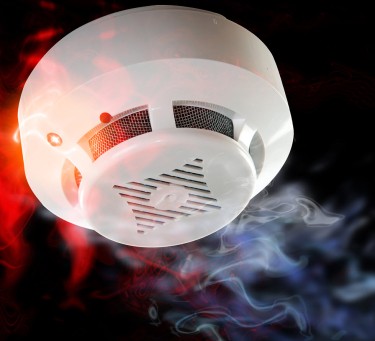
In recent years, the popularity of electronic cigarettes and vaping has surged. As vaping enthusiasts tend to indulge in their habit anywhere, it becomes essential to consider the potential interaction between vapor and smoke alarms. If you’ve ever questioned whether vapes can trigger smoke alarms, this article addresses that concern.
Understanding Smoke Alarms
Smoke alarms play a crucial role in safeguarding lives by detecting smoke and warning occupants of a building about potential fire hazards. Found in every home and building, these devices provide timely alerts, allowing people to evacuate swiftly in the event of a fire.
The rise in vaping has sparked curiosity regarding whether the vapor emitted from e-cigarettes can activate smoke detectors. These detectors are designed to identify airborne smoke particles, issuing an alert when the concentration of these particles in the air reaches a specific threshold.
While smoke alarms are primarily intended for serious fire situations, they can occasionally be triggered by other airborne particles such as dust, steam, kitchen smoke, and vapor. Therefore, it is advisable to strategically install smoke detectors away from potential sources of false alarms to ensure their effectiveness.
Varieties of Smoke Alarms
If you’re worried about your vape triggering a smoke alarm, it’s essential to understand that smoke detectors come in different types. There are three main categories of smoke detectors: ionization smoke detectors, photoelectric smoke detectors, and dual-sensor smoke detectors.
Ionization Smoke Alarms
Ionization smoke alarms function by ionizing the air within the smoke detector using a small amount of radioactive material. The alarm activates when smoke particles enter the chamber and disrupt the ionization process. These smoke alarms excel at detecting small, burning flames, making them more susceptible to being set off by vaping.
Photoelectric Smoke Alarms
Conversely, photoelectric smoke alarms use a light beam to detect smoke in the air. The alarm triggers when smoke enters the chamber and reflects light onto a sensor. These smoke alarms are more adept at detecting larger flames. While they may be activated by vaping, it is less likely compared to ionization smoke alarms.
Dual-Sensor Smoke Alarms
Apart from ionization and photoelectric smoke alarms, dual-sensor smoke alarms combine both technologies for enhanced detection capabilities. This type of alarm is highly prone to being triggered by vaping due to its comprehensive approach to sensing different types of smoke particles.
Can Vaping Activate Smoke Alarms?
In general, yes, vaping has the potential to set off a smoke detector. If you’re indulging in a few modest puffs with a disposable or pod vape, you’re less likely to encounter an issue. However, users of sub-ohm tanks or rebuildable setups may need help to vape discreetly due to the substantial vapor output associated with these devices.
The likelihood of a vape triggering a smoke alarm depends on various factors. One such factor is the size of the room. In smaller spaces, the vapor from an e-cigarette becomes more concentrated, increasing the probability of setting off a smoke alarm.
The type of smoke alarm used is another influencing factor. Ionization and dual-sensor smoke alarms are more susceptible to being activated by e-cigarette vapor compared to photoelectric smoke alarms. However, this susceptibility can vary depending on the specific brand of the smoke alarm.
Furthermore, the quantity of vapor produced plays a role in whether it triggers a smoke alarm. Smoke alarms are more prone to activation when using larger, more powerful vapes that emit a substantial amount of vapor, such as sub-ohm tanks and mod setups.
Guidelines for Vaping Without Triggering Smoke Alarms
Even though vaping does not generate smoke in the conventional sense, it is nevertheless possible for some kinds of smoke detectors to be triggered by it.
If you’re willing to take the risk but want to minimize your chance of setting off a smoke alarm, consider the following recommendations:
Identify the Smoke Detector Type
Different kinds of smoke detectors react more or less sensitively to vapor. Smoke alarms that use ionisation technology, for instance, are more susceptible to being triggered by vapor, whereas smoke alarms that use photoelectric technology are less likely to be triggered. To be safe, it’s best to refrain from or minimize vaping if you aren’t sure what kind of smoke detector is installed in the room.
Opt for a Low-Power Device
If you’re worried about setting off a smoke alarm, one solution is to switch to a low-power device like a disposable or a pod vape. These devices work at lower wattages than mod and tank setups and thus produce less vapor. This reduces the quantity of vapor in the air and makes it less likely that you’ll set off a smoke detector.
Use a High-PG Ejuice
Ejuices consist of two primary ingredients: Vegetable Glycerin (VG), Propylene Glycol (PG), or both. VG is responsible for the clouds, while PG is responsible for the “throat hit” and also acts as a flavor carrier. Using a high-PG ejuice will eliminate a lot of the vapor produced by your vape, making it less likely to set off a smoke detector.
Vaping Near an Open Window is Advisable.
If feasible, choose to vape alongside an open window and expel the vapor outside to minimize the chances of triggering a smoke alarm. However, it’s essential to note that this approach may not always be successful, particularly in cramped spaces or areas with insufficient ventilation.
Steer Clear of Vaping in Confined Areas.
If possible, refrain from vaping in tight quarters. The concentration of visible vapor tends to be higher in small spaces, increasing the likelihood of activating a smoke alert. If vaping in a confined space is unavoidable, opt for low-vapour e-juice and implement measures to ensure rapid vapor dissipation.
Use a Fan to Direct Vapor Downward and Away.
Reducing the risk of triggering a smoke alarm can be achieved by using a fan to guide vapor downward and away. This method not only redirects the vapor but also facilitates quicker dissipation. This simple yet effective technique can help prevent smoke detectors from being activated.
Bottom Line
As vaping gains popularity, the potential interaction with smoke alarms raises concerns. While vaping may not produce conventional smoke, various types of smoke detectors react differently to vapor. It’s crucial to consider factors such as the type of smoke alarm, room size, and vapor quantity when assessing the risk of triggering alarms. To minimize this risk, vapers are advised to identify their smoke detector type, opt for low-power devices and high-PG ejuices, and implement strategies like vaping near open windows or using fans for vapor dispersion. Being mindful of these considerations will allow enthusiasts to enjoy vaping safely and responsibly, recognizing the nuances associated with different smoke alarm technologies.
VAPE PENS AND CARTS AND WHAT TO DO WITH THEM, READ ON…
VAPE PEN DISPOSAL METHODS, WHAT IS CORRECT?
- SEO Powered Content & PR Distribution. Get Amplified Today.
- PlatoData.Network Vertical Generative Ai. Empower Yourself. Access Here.
- PlatoAiStream. Web3 Intelligence. Knowledge Amplified. Access Here.
- PlatoESG. Carbon, CleanTech, Energy, Environment, Solar, Waste Management. Access Here.
- PlatoHealth. Biotech and Clinical Trials Intelligence. Access Here.
- Source: http://cannabis.net/blog/vaping/can-vape-pens-trigger-smoke-alarms-in-buildings-or-planes




